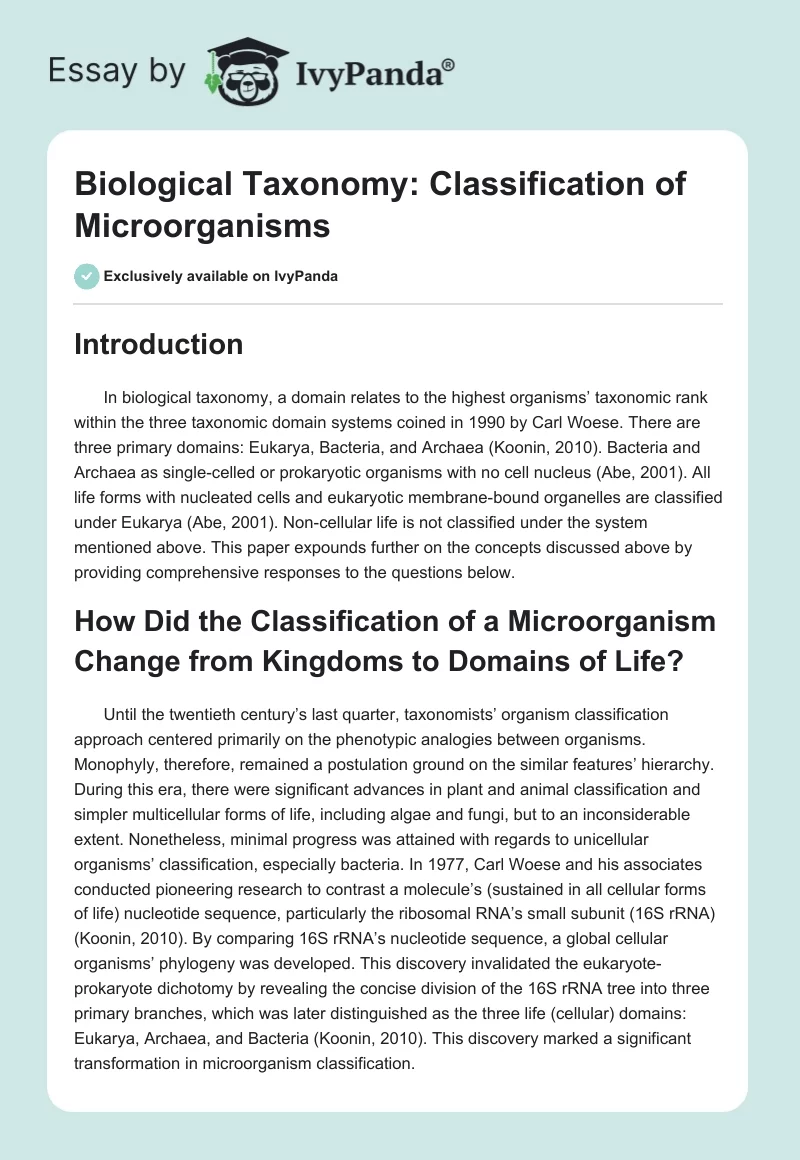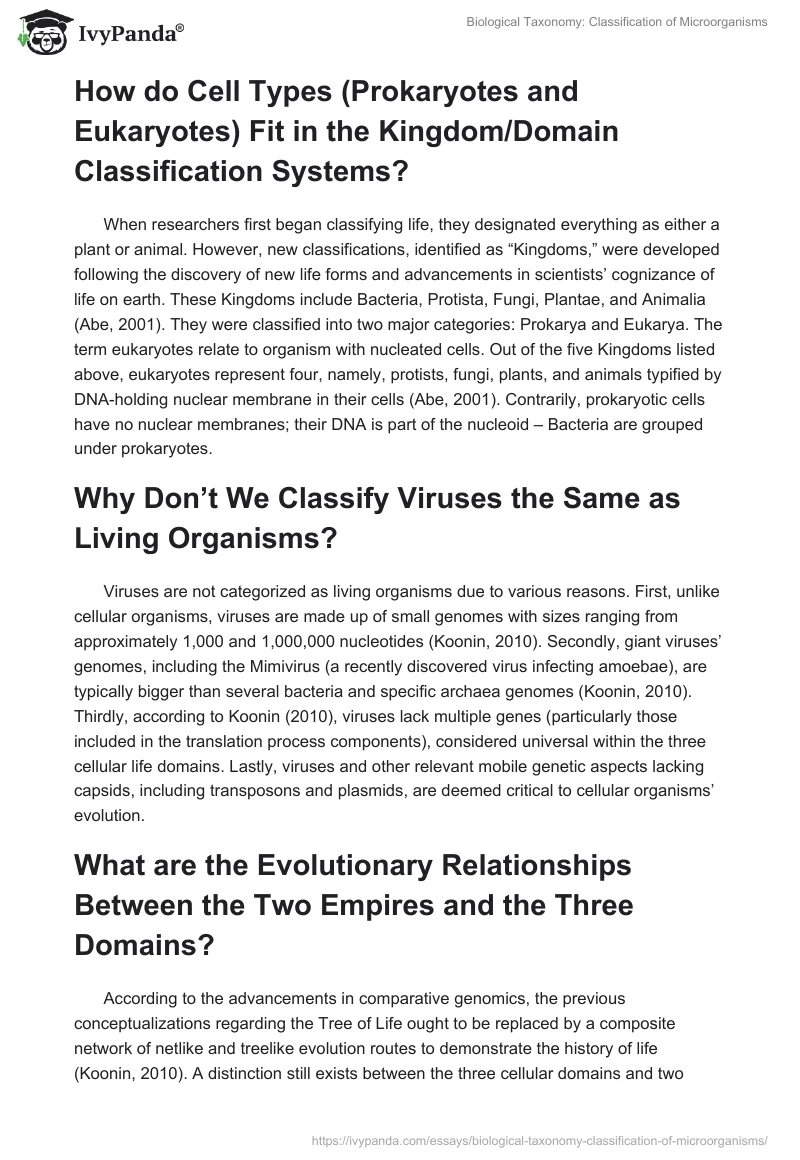Introduction
In biological taxonomy, a domain relates to the highest organisms’ taxonomic rank within the three taxonomic domain systems coined in 1990 by Carl Woese. There are three primary domains: Eukarya, Bacteria, and Archaea (Koonin, 2010). Bacteria and Archaea as single-celled or prokaryotic organisms with no cell nucleus (Abe, 2001). All life forms with nucleated cells and eukaryotic membrane-bound organelles are classified under Eukarya (Abe, 2001). Non-cellular life is not classified under the system mentioned above. This paper expounds further on the concepts discussed above by providing comprehensive responses to the questions below.
How Did the Classification of a Microorganism Change from Kingdoms to Domains of Life?
Until the twentieth century’s last quarter, taxonomists’ organism classification approach centered primarily on the phenotypic analogies between organisms. Monophyly, therefore, remained a postulation ground on the similar features’ hierarchy. During this era, there were significant advances in plant and animal classification and simpler multicellular forms of life, including algae and fungi, but to an inconsiderable extent. Nonetheless, minimal progress was attained with regards to unicellular organisms’ classification, especially bacteria. In 1977, Carl Woese and his associates conducted pioneering research to contrast a molecule’s (sustained in all cellular forms of life) nucleotide sequence, particularly the ribosomal RNA’s small subunit (16S rRNA) (Koonin, 2010). By comparing 16S rRNA’s nucleotide sequence, a global cellular organisms’ phylogeny was developed. This discovery invalidated the eukaryote-prokaryote dichotomy by revealing the concise division of the 16S rRNA tree into three primary branches, which was later distinguished as the three life (cellular) domains: Eukarya, Archaea, and Bacteria (Koonin, 2010). This discovery marked a significant transformation in microorganism classification.
How do Cell Types (Prokaryotes and Eukaryotes) Fit in the Kingdom/Domain Classification Systems?
When researchers first began classifying life, they designated everything as either a plant or animal. However, new classifications, identified as “Kingdoms,” were developed following the discovery of new life forms and advancements in scientists’ cognizance of life on earth. These Kingdoms include Bacteria, Protista, Fungi, Plantae, and Animalia (Abe, 2001). They were classified into two major categories: Prokarya and Eukarya. The term eukaryotes relate to organism with nucleated cells. Out of the five Kingdoms listed above, eukaryotes represent four, namely, protists, fungi, plants, and animals typified by DNA-holding nuclear membrane in their cells (Abe, 2001). Contrarily, prokaryotic cells have no nuclear membranes; their DNA is part of the nucleoid – Bacteria are grouped under prokaryotes.
Why Don’t We Classify Viruses the Same as Living Organisms?
Viruses are not categorized as living organisms due to various reasons. First, unlike cellular organisms, viruses are made up of small genomes with sizes ranging from approximately 1,000 and 1,000,000 nucleotides (Koonin, 2010). Secondly, giant viruses’ genomes, including the Mimivirus (a recently discovered virus infecting amoebae), are typically bigger than several bacteria and specific archaea genomes (Koonin, 2010). Thirdly, according to Koonin (2010), viruses lack multiple genes (particularly those included in the translation process components), considered universal within the three cellular life domains. Lastly, viruses and other relevant mobile genetic aspects lacking capsids, including transposons and plasmids, are deemed critical to cellular organisms’ evolution.
What are the Evolutionary Relationships Between the Two Empires and the Three Domains?
According to the advancements in comparative genomics, the previous conceptualizations regarding the Tree of Life ought to be replaced by a composite network of netlike and treelike evolution routes to demonstrate the history of life (Koonin, 2010). A distinction still exists between the three cellular domains and two empires, particularly under the advanced evolution perspective (Koonin, 2010). Moreover, comparative genomics’ discoveries distinguish eukaryotes as archaebacterial chimeras that evolved as a consequence of or under a powerful influence of the endosymbiotic process, which led to the emergence of mitochondria.
Conclusion
Comparative genomics reveal that life forms consist of two primary divisions: viral and cellular empires. Carl Woese and his associates made a revolutionary research discovery that invalidated the eukaryote-prokaryote dichotomy by revealing the concise division of the 16S rRNA tree into three primary branches. Kingdoms are classified into two major categories: Prokarya and Eukarya. Viruses are not classified as living organisms due to various reasons, including their small genome composition.
References
Abe, S. (2001). The three domains of life. Astrobiology at NASA. Web.
Koonin, E. V. (2010). The two empires and three domains of life in the postgenomic age.Nature Education, 3(9), 27. Web.


